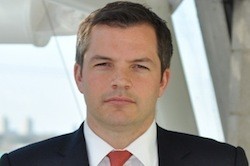
As centers of market monitoring, exchanges are on a perpetual search for technology that will enable greater control and observation of data.
However, such controls need to be implemented in such a way that latency on their platforms is not affected, as to remain competitive versus peers.
“Origination of trading activity is the key here, in that to get the full picture of a trade’s intent, the full sequential stream of trade messages (orders, amends, cancels and executions) needs to be captured and analyzed,” said John Edge, managing director, capital markets and business development at NICE Actimize.

John Edge, NICE Actimize
In a world pre-fragmentation, the logical place for this to occur was at the exchange, the central hub for all trade messages.
When fragmentation occurred, this central hub at the exchange level was removed, rendering single exchanged-based surveillance solutions and procedures as not fit for purpose.
“The use case being that if a broker places orders on multiple exchanges, and executes on multiple exchanges, the sequential history cannot be sourced from one central exchange,” said Edge. “There is an opportunity to do this if the securities are centrally cleared (as in the Futures market) however in equities this is not the case. Therefore, exchange- based trade surveillance in fragmented markets is a flawed practice.”
Within the high-frequency trading community there is an understanding that lack of transparency into trading activities is breeding fear and mistrust. As such, any efforts that can demonstrate a willingness to submit to authority and prove compliance are attractive propositions in the face of potential industry changes that could permanently alter the HFT model on revenue generation.
“High frequency trading is a fact of life in today’s equity markets,” said Alfred Eskandar, CEO of Portware. “Short of any future regulations that would effectively ban the practice, HFT will continue to represent a significant portion of volumes in lit markets. I don’t think exchanges should be faulted for creating the technology or infrastructure that ultimately attracts more order flow.”
With HFT providing a large percentage of the markets liquidity, and therefore revenues, exchanges need to evolve to deliver the services that attract such order flow/revenue streams.
“The requirements are centered on execution performance and data quality, with latency, order types and market data feeds being critical, noting hosting facilities and managed services as an ever-increasing requirement,” said Edge.
Edge has an in-depth understanding of the requirements of market participants and is an expert in investment lifecycles in investment banks, execution management systems, algorithmic trading platforms, order management systems, and global exchange operations, gained through positions in electronic trading technology at CLSA G-Trade, UBS, Lehman Brothers, and JP Morgan.
What is required is to build a full sequential stream of trade messages in order that a systematic/algorithmic process can analyze the data to detect the patterns required for detecting prohibited behavior. “This is the challenge of today’s trade surveillance solutions: the aggregation of sequential trade messages to provide a full picture of the trade’s lifecyle,” Edge said.
Data aggregation, in a sequenced, normalized, query-able format is the current Holy Grail for compliance and risk management teams.
“If you cannot get a clear picture of the trade data, then it does not matter how good your analytics are or how interactive the front end is, the results will be relatively useless,” said Edge.
“The key here is to understand the trading ecosystem and what trading system constructs are used throughout the industry,” he said. “This is no mean feat and requires expertise garnered from the trading environments. Data aggregation has occurred in trading to drive smart order routers, and now a similar task is required in compliance.”






